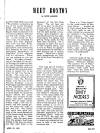Home Page
Meet Boston Menu
Index
New England once had a dictator, as absolute as any of the current European breed. His name was Sir Edmund Andros, and it took an English fleet to establish him in control in Boston, where he was left with a body of militia. In the course of four years reign, he extended his control over New England, New York and New Jersey, stopping representative organizations and confiscating land wherever he went, and demanding declarations of allegiance from everyone with his ultimatum: "Either you are subjects or you are rebels." His habit of marching at the head of his militia through the streets of Boston was thoroughly noted by the people, and the route was so regular that everyone knew where to expect him to go when he felt like having a parade. The route was (to use the modern names of the streets) from the Province House (now the site of the Province Building along Washington and State Streets to the waterfront. On the morning of [Monday] April 18, 1689, when he turned the corner into State Street, he found the square behind the corner (which was invisible till the corner had been reached) filled with an angry crowd. Andros made a few hot remarks, and then started giving the troops the order to aim and fire. But, before they could take good aim, more of the crowd poured out of the houses along the street (where now is No.1 State Street), took the guns away from the soldiers, and threw Andros in the town jail which was then right there in the House. The jail bars are still to be seen, on the Devonshire side of the building. A legend has it that, just before the fight started, a mysterious "gray champion" appeared between the two sides, encouraging the people and getting things ready for the fight, then vanishing. He is supposed to typify the spirit of New England liberty, and is said to make his appearance whenever the liberties of New England are in serious danger. About half a dozen other appearances are credited to the Gray Champion by legend.* That wide part of Franklin Street, where it takes a big curve just below Washington Street, is a bit out of harmony with the narrow streets of downtown Boston, and is quite conspicuous on that account. Before the Great Fire, the outside of that curve was a distinct street, separated from Franklin Street by a small crescent-shaped park. This street, called Tontine Row, was Boston's insurance district of the days before the Fire. Its name had an insurance significance, as a "tontine" was the earliest form of life insurance (a club which pooled a certain amount of money, to be paid to the survivor), invented by one Tonti, who also did considerable exploration in the Mississippi Valley. After the Fire of 1872, the park was not reconstructed, and Franklin Street was widened at that point to take in the former insurance row. * There is a "false bottom" to the inside tracks at Kenmore Station . . . another set of tracks about three feet below them, ready to use, if, when, and as train service will be installed in the Boylston Street Subway. The platforms of East Boston Tunnel stations (except Maverick, which opened when train service started) likewise have a false bottom . . . the old platforms, used before 1924, when trolleys ran through the tunnel, lie underneath. * National songs of two nations have been composed in Boston. America's anthem, "My Country 'Tis of Thee," and the Canadian song "O Canada," both came from here. Very few cities have attained this distinction.
|
